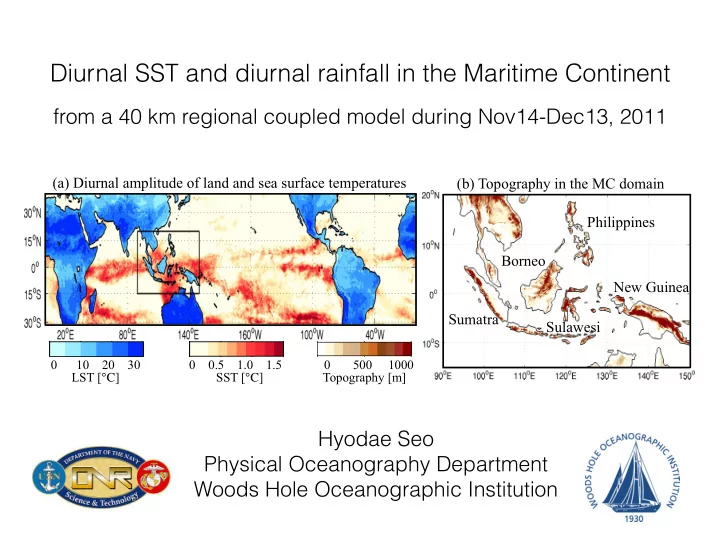

Diurnal SST and diurnal rainfall in the Maritime Continent from a 40 km regional coupled model during Nov14-Dec13, 2011 (a) Diurnal amplitude of land and sea surface temperatures (b) Topography in the MC domain Philippines Borneo New Guinea Sumatra Sulawesi 0 10 20 30 0 0.5 1.0 1.5 0 500 1000 LST [ ℃ ] SST [ ℃ ] Topography [m] Hyodae Seo Physical Oceanography Department Woods Hole Oceanographic Institution
SCOAR regional coupled model Atmosphere Ocean atmos model / bulk • 40 km O-A resolutions physics: τ , Q flux , FW • Tropical channel WRF • 5 ensemble members ROMS Coupler Scripps RSM • Nov 14-Dec 13, 2011 SST & sfc. current CF1 : 1-hr coupling daily HYCOM 6-h ERA-Interim CF1DM : WRF forced with Daily-Mean CF1 SST CF24 : 24-hr coupling Seo et al. (2014): J. Climate Coupled impacts of the diurnal cycle of sea surface temperature on the Madden-Julian Oscillation.
Rainfall time-series over land and ocean Land Ocean
Hourly rainfall composites Rainfall over land mm/hr Rainfall over the ocean mm/hr Reduced early morning rainfall in both land and ocean
Hourly surface temperature composites LST MC ℃ SST MC ℃ Reduced land-sea thermal contrast during the morning and night hours
Diurnal amplitude of rainfall TRMM D-PCP CF1 D-PCP mm/hr mm/hr (CF1-CF1DM)/CF1 D-PCP % Change CF1DM D-PCP %
Diurnal amplitude of land surface temperatures CF1 D-LST Land ONLY (CF1-CF1DM)/CF1 D-LST % Change % ℃ CF1DM D-LST Land ONLY D-SST in CF1
Peak rainfall hours TRMM Diurnal peak hour CF1 Diurnal peak hours LST LST CF1DM Diurnal peak hours CF1-CF1DM; difference in peak hours hrs
Offshore propagation: Sumatra Similar to LST Mori et al. 2004 mm/hr LST 800 600 orography (meter) 400 200 0
Summary • Preliminary, 1-month integration, coarse h/v resolutions • Diurnal fluctuation in SST (with the identical time-mean) • enhances the diurnal amplitude of rainfall • modulates the diurnal amplitude of LST as much as 10% • shifts the rainfall peak by up to ±3 hrs throughout the MC islands • offshore march of the diurnal rainfall stronger and more coherent • Plan to use an explicit convection regional coupled model with one- way and two-way nesting • To represent the land-diurnal convection, gravity wave response to convective heating, and land-sea breezes. • To examine the resulting air-sea interaction and the influence on the MCS formation, the MC-wide rainfall, and the MJO propagation.
Recommend
More recommend